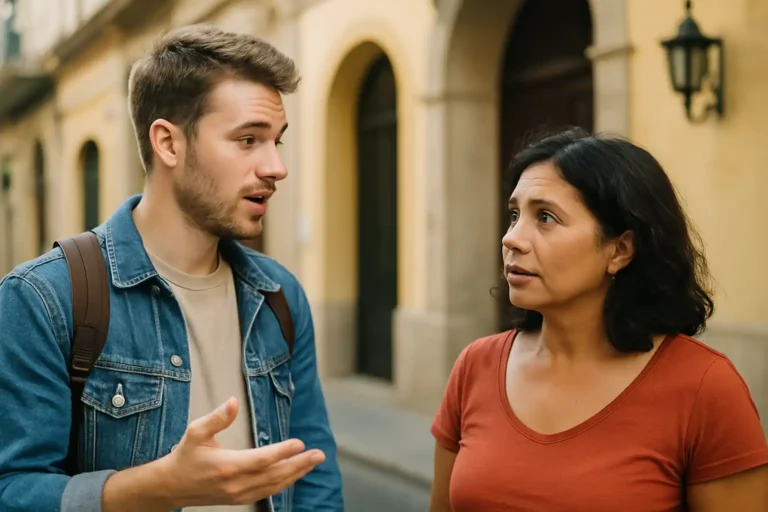Why Learn the Phrase “Do You Speak English” in Spanish Matters
How do you say do you speak English in Spanish? It’s a simple question — but a powerful one. Knowing how to ask someone if they speak English can completely change how smoothly your travels go in Spanish-speaking countries.
Here’s the go-to phrase:
🗣️ ¿Habla inglés?
(Pronounced: AH-blah een-GLEHS?)
It literally means, “Do you speak English?”
🌎 So, why is this tiny sentence so important?
🛫 It helps break the ice politely in unfamiliar situations
💬 It shows respect for the local language before switching to English
🧭 It can help you quickly find someone who can assist you in English
Even if you’re just starting to learn basic Spanish phrases, this one is an essential tool for confident travel. Plus, it pairs well with other essential Spanish phrases like:
“Lo siento, no hablo español.” (Sorry, I don’t speak Spanish.)
“¿Puede ayudarme?” (Can you help me?)
“Más despacio, por favor.” (Slower, please.)
💡 Want to know where this phrase is most useful? Check out Do They Speak English in Costa Rica 7 Facts for Travelers — it’s full of real-world examples where this phrase comes in handy.
And now… let’s learn the phrase step by step.
Table of Contents
Step 1: Learn the Exact Translation – Word by Word
Let’s break down how do you say do you speak English in Spanish — literally and clearly.
📌 ¿Habla inglés?
¿ – turns the sentence into a question
Habla – “Do you speak” (from the verb hablar)
Inglés – “English”
🌟 Bonus: If you want to be even more polite, add usted at the end: 👉 ¿Habla inglés usted? (Do you speak English, sir/ma’am?)
This structure is especially useful for formal situations — like asking a hotel receptionist, taxi driver, or airport staff.
If you want to go informal (maybe when speaking to someone your age), use:
👉 ¿Hablas inglés? (Notice the “s” at the end of hablas)
These basic Spanish phrases follow the common subject-verb-object order and are perfect for travel.
And if you’re serious about expanding your toolkit, How to Say I Don’t Speak English in Spanish 5 Easy Expressions gives you even more smart sentence pairings to use in everyday conversations.
🧠 Ready to take your skills to a professional level too? Check out Master Business English in 2025: Vocabulary, Idioms, and Conversations — it’s perfect for anyone working or networking internationally.

Step 2: Master the Pronunciation and Tone
You’ve learned the phrase. But now let’s focus on how to say it naturally.
🗣️ Say it with me: ¿Habla inglés?
(“AH-blah een-GLEHS”)
✅ Tip 1: Keep your tone gentle and rising at the end — like asking a polite question.
✅ Tip 2: Put emphasis on inglés, since that’s the keyword.
✅ Tip 3: Try practicing in front of a mirror or with a language buddy.
🎯 Real-world trick: Pair this phrase with a friendly smile and body language — it helps make up for any accent you may still be working on.
These techniques are part of improving your overall Spanish conversation skills, especially when navigating multilingual areas.
✨ And if you’ve been traveling around Asia too, check out Do You Speak English in Japanese 7 Key Phrases You Should Know. You’ll notice that tone and gesture are just as important as words — globally!
The goal here is to feel confident speaking, not perfect. And remember, locals really do appreciate your effort to use essential Spanish phrases — even if you stumble a bit at first!
Step 3: Practice in Realistic Situations
Now that you know how do you say do you speak English in Spanish, let’s bring it into real life.
Here are some common situations where you can (and should!) use it:
🛫 At the airport:
“¿Habla inglés?” → to ask about baggage or gate changes
🛍️ At a shop or street market:
“¿Habla inglés?” → when looking for help choosing an item
🚕 In a taxi:
“¿Habla inglés?” → if you want to explain your destination more easily
Don’t worry if you forget a word — gestures and facial expressions work wonders. And if someone says “no,” you can point to your phone and use a translation app. That’s why english spanish translation tools like Google Translate can be your backup buddy!
These practical situations are where your basic Spanish phrases really shine. It’s not about grammar tests — it’s about real communication!
Need help expanding your language learning? Here’s 5 Easiest Languages to Learn for Spanish Speakers to Master Fast — a helpful read if you’re thinking beyond Spanish.
And for some global language context, explore the rich history of the english language — it’s fascinating how it connects people across cultures!

Other Essential Spanish Questions That Pair Well
When you’ve mastered how do you say do you speak English in Spanish, it’s time to add a few more useful phrases to your travel toolbox.
🧠 Why? Because language learning is about building bridges — and having a few essential Spanish phrases in your pocket makes every trip smoother.
🌟 Here are some perfect pairings:
❓ ¿Dónde está el baño? – Where is the bathroom?
❓ ¿Cuánto cuesta? – How much does it cost?
❓ ¿Qué recomienda? – What do you recommend?
These are fantastic for anyone improving their Spanish conversation skills or navigating restaurants, hotels, and shops with confidence.
✨ Want to learn how to deal with the opposite situation — when you don’t speak English? Read I Don’t Speak English 5 Easy Ways to Communicate Better Abroad — it’s full of non-verbal tricks and polite expressions!
You don’t need to speak fluently to connect. Just a few words and a kind tone go a long way.
Common Mistakes When Saying “Do You Speak English” in Spanish
Even simple phrases like how do you say do you speak English in Spanish can trip us up when we’re nervous or rushing. Let’s go over a few common mistakes and how to avoid them!
🚫 Saying “Habla inglés” like a statement instead of a question.
✅ Always start with ¿ and end with a rising tone.
🚫 Forgetting to pronounce the s in inglés
✅ Make sure it’s not confused with inglé, which isn’t a word!
🚫 Mixing up verb conjugation: saying hablas instead of habla in formal settings
✅ Use habla for polite situations and hablas for informal ones.
✨ Reminder: These mistakes are part of learning! Everyone starts somewhere — even native speakers of English had to start with basic Spanish phrases at some point.
If you ever feel unsure, pause, smile, and try again. Most people are happy to help — especially when you’re making the effort.
How to Improve Your Spanish-English Conversation Skills
So you’ve learned how do you say do you speak English in Spanish — now, how can you keep improving from here?
🎯 Here are some tips to level up your Spanish conversation skills:
📱 Use language apps like Duolingo or Memrise daily
🎧 Listen to Spanish podcasts with English transcripts
👥 Practice with friends or native speakers in short, real dialogues
✍️ Write simple sentences and read them aloud
You can also switch your phone or browser language to Spanish for short periods — it’s a fun way to boost english spanish translation awareness without too much pressure.
And of course, practicing real phrases like “¿Habla inglés?” in safe, everyday settings builds your confidence fast.
💬 Got questions about your learning? Just Contact Us — we’re here to support your language journey anytime!
Language is all about connection — and you’re already on the path to making beautiful ones.
Related Posts

Do People in Turkey Speak English What You Should Know
Do people in Turkey speak English Learn where English is spoken and how easy it is to communicate as a traveler

Can You Speak English How to Ask and Answer Politely
Can you speak English Learn the best ways to ask and respond to this question politely in different travel and social settings

7 Books to Expand Your English Vocabulary Fast
Books to expand vocabulary help you speak and write better Discover top books that make learning new words enjoyable
